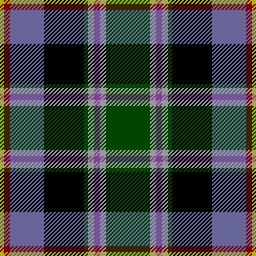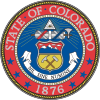
A kilt is a type of knee-length non-bifurcated skirt with pleats at the back, originating in the traditional dress of Gaelic men and boys in the Scottish Highlands. It is first recorded in the 16th century as the great kilt, a full-length garment whose upper half could be worn as a cloak. The small kilt or modern kilt emerged in the 18th century, and is essentially the bottom half of the great kilt. Since the 19th century, it has become associated with the wider culture of Scotland, and more broadly with Gaelic or Celtic heritage. It is most often made of woollen cloth in a tartan pattern.
All of Canada's provinces and territories, except for Nunavut, have regional tartans, as do many other regional divisions in Canada. Tartans were first brought to Canada by Scottish settlers; the first province to adopt one officially was Nova Scotia in 1956, and the most recent province was Ontario, in 2000. Except for the tartan of Quebec, all of the provincial and territorial tartans are officially recognized and registered in the books of the Court of the Lord Lyon, King of Arms of Scotland. The tartan for Canada as a whole is known as the maple leaf tartan and became an official national symbol in 2011.

Mess dress uniform is the military term for the evening dress worn by commissioned officers and non-commissioned officers in their respective messes or on other more formal occasions. It is also known as mess uniform and, more informally, as mess kit. It frequently consists of a mess jacket and trousers worn with a white formal dress shirt and other formal accessories, though the exact form varies depending on the uniform regulations for each service.

An argyle pattern is made of diamonds or lozenges. The word is sometimes used to refer to an individual diamond in the design, but more commonly refers to the overall pattern. Most argyle contains layers of overlapping motifs, adding a sense of three-dimensionality, movement, and texture. Typically, there is an overlay of intercrossing diagonal lines on solid diamonds.
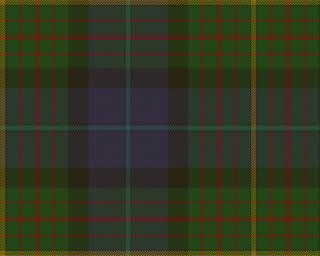
The California State Tartan is the official Scottish Tartan pattern of California, created July 23, 2001 and defined under law in California state government code 424.3,

The history of the kilt stretches back to at least the end of the 16th century. The kilt first appeared as the belted plaid or great kilt, a full length garment whose upper half could be worn as a cloak draped over the shoulder, or brought up over the head as a hood. The small kilt or walking kilt did not develop until the late 17th or early 18th century, and is essentially the bottom half of the great kilt.
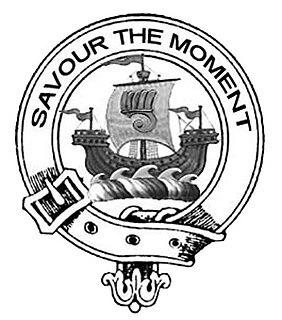
The personal name Duncan can be found in Scotland’s oldest records in its Gaelic form Dunchad/Donchadh/Donachie/Donnchadh and other spelling variants.

The Royal Air Force uniform is the standardised military dress worn by members of the Royal Air Force. The predominant colours of Royal Air Force uniforms are blue-grey and Wedgwood blue. Many Commonwealth air forces' uniforms are also based on the RAF pattern, but with nationality shoulder flashes. Cadets of the RAFAC which includes the ATC and CCF (RAF) Sections wear similar uniforms.

The United States Air Force uniform is the standardized military attire worn by airmen of the United States Air Force. Specific Air Force Instructions address standardized wear that is identical for members of both the Active Component and that of the service's two reserve components that comprise the Air Reserve Component, that being the Air Force Reserve and the Air National Guard. This includes personnel in the Air Force's sole enlisted accession program, Basic Military Training (BMT), and the three USAF commissioned officer accession programs: Officer Training School (OTS) officer trainees, college/university level Air Force Reserve Officers' Training Corps (AFROTC) cadets and United States Air Force Academy (USAFA) cadets. Provisions are also included for authorized wear on certain occasions by honorably retired career members of the Air Force.

Clan MacEwen or Clan MacEwan is a Highland Scottish clan recorded in the fifteenth century as Clan Ewen of Otter.

Battenburg markings or Battenberg markings are a pattern of high-visibility markings used primarily on the sides of emergency service vehicles in several European countries as well as in New Zealand, Australia, Hong Kong, and Trinidad and Tobago. The name comes from its similarity in appearance to the cross-section of a Battenberg cake.

Border tartan, sometimes known as Northumbrian tartan, Shepherds' Plaid or Border Drab, or Border check is a design used in woven fabrics historically associated with the Anglo-Scottish Border, including the Scottish Borders and Northumbria. Possibly the most identifiable Border tartan garment of the region is the maud (plaid), made popular from the 1820s by fashionable Border Scots such as Sir Walter Scott, James Hogg, Henry Scott Riddell and Robert Burns.

Sillitoe Tartan is the nickname given to the distinctive black and white chequered pattern correctly known as dicing, which was originally associated with the police in Scotland, but which later spread to Australia, New Zealand, and the rest of the United Kingdom, as well as to some other places such as Chicago and Pittsburgh in the United States and in parts of Canada to distinguish members of the Auxiliary Police. Based on the diced bands seen on the Glengarries that are worn by several Scottish regiments of the British Army, the pattern was first adopted for police use in 1932 by Sir Percy Sillitoe, Chief Constable of the City of Glasgow Police.
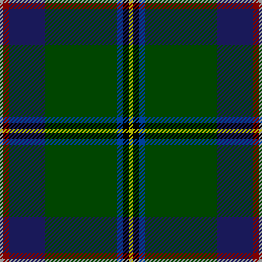
Washington state tartan is the official state tartan established by the Washington state legislature.
The law of Colorado consists of several levels, including constitutional, statutory, regulatory, local, and case law. The Colorado Revised Statutes form the general statutory law.

The United States Coast Guard Pipe Band is a pipe band and private military unit composed of current and former United States Coast Guard personnel. Though a privately maintained entity, it is formally recognized by the U.S. Coast Guard and provides support to official Coast Guard ceremonies including changes-of-command, funerals, and ship commissioning. The unit was established in 2001 and formally recognized by the U.S. Coast Guard as a Coast Guard-affiliated organization the following year.
